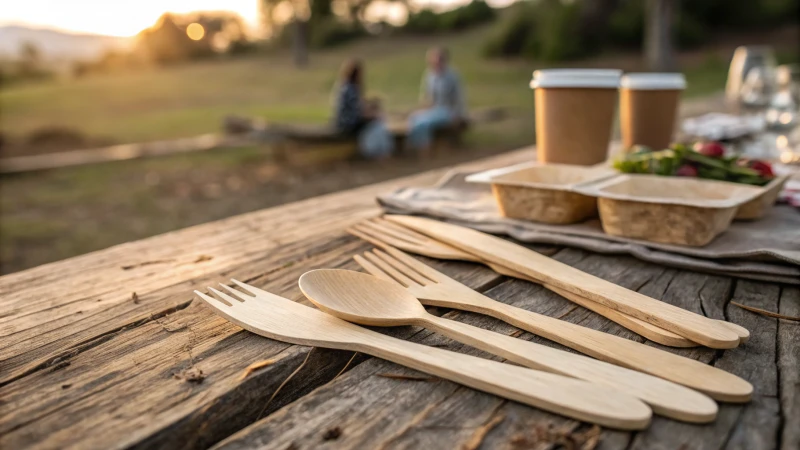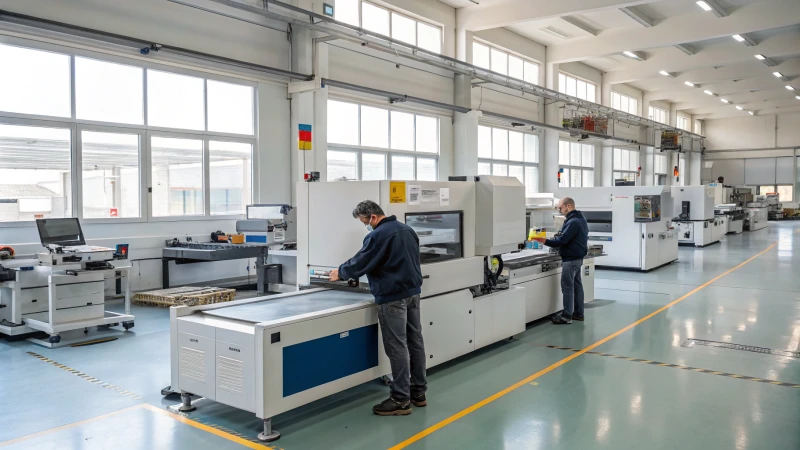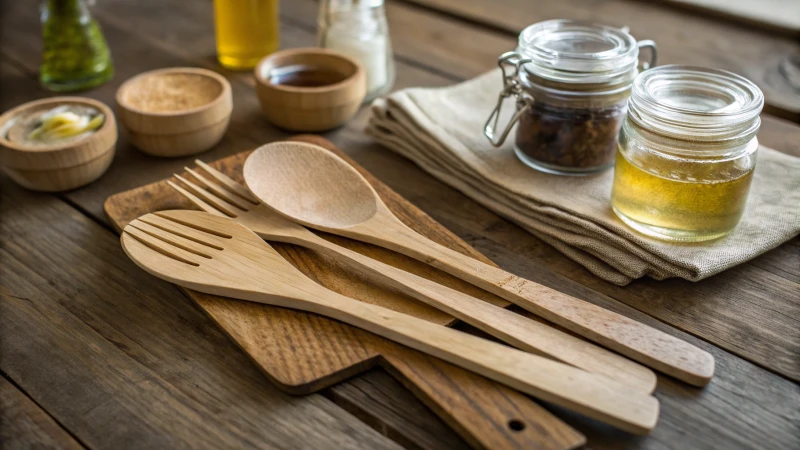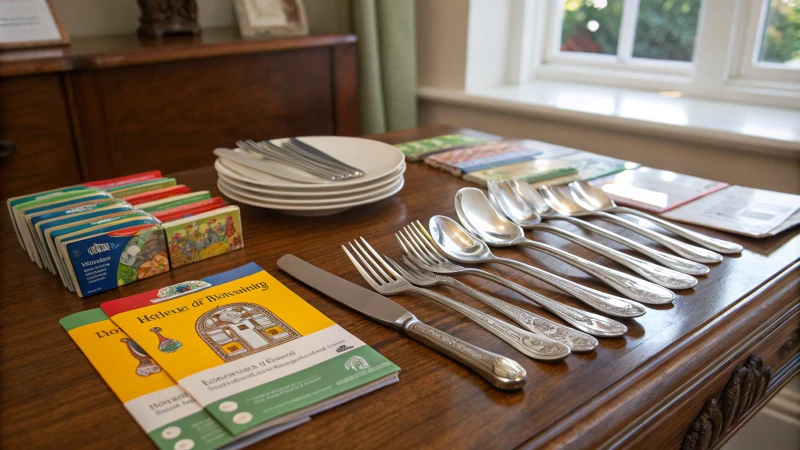
Ever thought about ways to help wooden cutlery last a long time and work well?
To extend the life of disposable wooden cutlery, I choose dense and durable woods. Precise crafting methods shape each piece accurately. Protective treatments, such as food-safe oils, shield the surface. Educating users on proper care procedures is key. These actions result in outstanding product performance. Eco-friendliness remains a priority.
These first steps start a strong base for better durability, but more options exist. Picture picking various woods like choosing the right spice in a recipe from your grandma. Each choice is crucial in building a top-quality product that pleases people and also cares for Earth. Discover ways these methods work together to produce wooden cutlery that is both dependable and eco-friendly.
High-density woods improve cutlery durability.True
Denser woods like birch and bamboo resist splintering and moisture.
Plastic coatings enhance wooden cutlery compostability.False
Plastic coatings hinder compostability, posing environmental challenges.
How Does Material Selection Impact Durability?
Ever thought about why some things just last longer than others? The secret hides in the materials we pick.
Selecting suitable materials matters greatly for strength because they decide a product's power to withstand weather, regular use and time. Materials that fit well improve how something works, lower the cost of repairs and increase how long it lasts. It is very important.

Material Selection Science
Exploring material selection is like discovering a hidden world full of options. Each material has unique traits, such as thickness, toughness, strength, and heat tolerance. For example, stainless steel kitchen tools have stayed reliable through many trends. This is because they resist rust and can handle high temperatures.
Weather Conditions
Weather matters a lot. Have you ever left something outside and found it warped or faded later? I learned this lesson when my favorite garden chair, made from poor material, suffered under the sun and rain. Using weather-resistant materials1 really helps.
| Material | Characteristics | Ideal Uses |
|---|---|---|
| Stainless Steel | Corrosion-resistant | Kitchen tools |
| Faux Leather | Trendy but less durable | Fashion items |
| Weather-Resistant Materials | UV resistant | Outdoor furniture |
Cost and Longevity
Balancing price and lifespan is always challenging. You desire quality without overspending. I once spent a lot on a top-tier bike, hoping it would last forever. It didn’t, teaching me that sometimes cheaper options can be smarter and still last long.
Sustainability Choices
Caring for the environment brings another aspect to choosing materials. Picking eco-friendly materials2 like bamboo or recycled metals supports nature while being durable. I still remember holding bamboo cutlery for the first time—a tiny move toward eco-friendly living yet felt really important.
Real-World Examples:
- Buildings: Skyscrapers use reinforced concrete to stand firm against disasters.
- Smartphones: Gorilla Glass protects screens with its scratch resistance.
- Cars: New polymers make car parts lighter without losing strength.
These real-life stories show that choosing the right materials decides a product’s life and success, just like that perfect pair of shoes which look really good yet stay cozy for years. To choose wisely, thinking about needs and how they'll be used is very important.
High-density woods improve cutlery durability.True
Dense woods like birch resist moisture and splintering better.
Plastic coatings enhance compostability of wooden cutlery.False
Plastic coatings improve moisture resistance but hinder compostability.
How Do Manufacturing Techniques Impact Product Quality?
Each time I pick up a wooden fork or spoon, I think about the careful process behind it. Precision meets craftsmanship. These simple tools come from a dance of skill and care. Sustainability sits at the heart of this dance.
Manufacturing techniques affect product quality by bringing precision, consistency and strong materials. Advanced methods such as precision cutting and quality control improve durability and performance. These methods also help reduce defects.

Precision in Manufacturing
I've always been fascinated by how precision in manufacturing turns simple materials into something extraordinary. Imagine every tool and machine working together to create products that match exact designs. It's like watching a dance of gears and levers! When I first heard about precision cutting, I felt like I found the key to building strong structures. This method is crucial in areas where even tiny mistakes could harm how a product works. Attention to detail is very important.
| Manufacturing Technique | Impact on Quality |
|---|---|
| Precision Cutting | Enhances structural strength |
| Automated Assembly | Reduces human error |
| Quality Control Checks | Identifies defects early |
Role of Automation
Automation is like a helpful friend who never gets tired. I've noticed how automated systems keep everything consistent across production batches. Each item perfectly matches the others, with uniformity in size and weight present. Automation removes human mistakes that often sneak into manual processes. Picture an assembly line that works all day and night, creating products with perfect precision. Automation is reliable.
Importance of Quality Control
Quality control feels like an unseen protector, but its effect is huge. Careful checks at every stage catch problems early, stopping faulty products from reaching people. This step keeps industry standards high. Trust grows with consumers because products are reliable again and again.
- Quality Control Methods
- Visual checks for surface problems
- Automated tests for how well things work
- Statistical sampling to keep batches consistent
Material Handling and Treatment
Handling and treating materials is like caring for a plant - it needs time and attention. Methods like heat treatment or protective coatings can really increase a product's lifespan. Imagine wooden cutlery: adding food-safe oils or waxes stops moisture absorption and bacterial growth3, making sure quality and safety stay top-notch.
These ideas remind me why good manufacturing techniques are key for top-quality products. By focusing on precision, automation, quality control, and material treatment, products not only meet expectations but go beyond them.
High-density woods improve cutlery durability.True
Dense woods like birch or bamboo resist splintering and moisture.
Plastic coatings enhance compostability of cutlery.False
Plastic coatings hinder compostability despite improving moisture resistance.
Why Should You Consider Protective Treatments for Wooden Cutlery?
Have you ever thought about whether your wooden utensils need special care to last longer? The answer might surprise you. Using protective treatments could be the key to extending the life of your kitchen tools. This method keeps wood in good condition. It might just be the secret to success.
Putting protective treatments such as food-safe oils or waxes on wooden cutlery is very important. These treatments stop moisture from soaking in and stop bacteria from growing. This greatly increases the lifespan and keeps them safe. Regular care keeps your utensils strong and clean.

Understanding Protective Treatments
I have always liked wooden cutlery very much. It's not only about their charming rustic appearance; wood feels personal during every meal. But, just like any relationship, it needs a little work. Protective treatments are similar to giving your wooden spoons and forks a nice spa day! By putting on food-safe mineral oils or those vegetable-based waxes, you give them a protective shield. This is important since wood likes to absorb moisture, which probably leads to warping or cracking.
Applying a protective layer can also prevent bacterial growth, ensuring the utensils remain hygienic over extended use. For those seeking eco-friendly solutions4, options like beeswax or coconut oil offer natural alternatives.
Comparing Treatment Options
When picking a treatment, think about how often you use your cutlery and what foods touch them. It's like choosing the right clothes for an event!
| Treatment Type | Benefits | Considerations |
|---|---|---|
| Mineral Oil | Easy to apply, non-toxic | Needs frequent reapplication |
| Beeswax | Provides a smooth finish, natural scent | Requires buffing for best results |
| Coconut Oil | Antimicrobial properties | Can leave a residue |
The Role of Protective Treatments in Sustainability
If you also want to take care of our planet, these treatments fit perfectly with sustainable living. They help wooden cutlery last longer, which means fewer replacements and less waste. This is helpful, especially in places like restaurants and catering5 where durability and cleanliness are priorities.
By choosing renewable treatments, consumers can maintain their commitment to sustainability while ensuring their cutlery remains in top condition. Additionally, understanding the specific environmental impact of each treatment can guide informed decisions.
Balancing Aesthetics and Functionality
Let’s not forget looks! A well-cared-for set of wooden cutlery is the star of any meal. Regular treatment with oils or waxes really keeps the wood grain beautiful.
For those who appreciate both design and practicality6, picking a treatment that goes well with the natural grain is important. This balance truly attracts attention in fancy dining settings where appearance is essential.
Ultimately, looking after wooden cutlery is like gardening. With some regular care, you enjoy something truly beautiful and useful!
High-density woods improve cutlery durability.True
Dense woods like birch resist splintering and moisture, enhancing durability.
Plastic coatings enhance wooden cutlery compostability.False
Plastic coatings improve moisture resistance but hinder compostability.
Why Is User Education Important for Maintaining Cutlery?
Did you ever experience a cooking mishap in the kitchen that could have been prevented with some simple knowledge?
Educating users is important for using cutlery safely, keeping it clean and avoiding harm. Knowledgeable people handle cutlery more effectively. They help cutlery last longer and work well.

Improving Safety with Proper Knowledge
Think of cutting a ripe tomato without any mess - no slipping, no cuts. That's what happens when you know how to use your knives correctly! Learning about safe storage and cutting methods helps protect our fingers and keeps kitchens safe, especially when children are present. Educated users are more likely to employ safe cutting techniques and proper storage methods. For example, ensuring knives are stored in a knife block or on a magnetic strip keeps them out of harm's way.
Supporting Hygiene Practices
Remember when you first understood that using the same cutting board for raw chicken and vegetables was wrong? Simple tips like this keep our meals safe. By knowing how to clean properly and when to use different tools, we avoid food poisoning and keep our cutlery in good condition. This includes learning how to thoroughly clean utensils to prevent cross-contamination.
Extending Cutlery Life
Cutting food with a sharp knife is very satisfying. I realized a big difference in sharpness when I started washing my knives by hand instead of using the dishwasher. Learning small habits like this helps our favorite utensils last much longer. Users taught how to maintain their utensils7 through regular sharpening and appropriate washing methods can avoid premature wear and tear.
Promoting Efficient Use
Trying to cut a steak with a butter knife is annoying and difficult! Knowing which tool to use for each job makes eating more enjoyable and reduces pressure on our cutlery, keeping them working well over time. Educated users can select the appropriate knife or fork for specific foods, which not only enhances the dining experience but also reduces unnecessary stress on utensils.
| Key Aspect | Importance | Example Practice |
|---|---|---|
| Safety | Reduces Accidents | Store knives safely |
| Hygiene | Prevents Contamination | Separate raw and cooked foods |
| Longevity | Extends Lifespan | Hand wash knives |
| Efficiency | Enhances Use | Use correct utensil |
The Role of Educational Programs
Think of a workshop that not only teaches care for cutlery but also inspires responsibility for sustainability. These programs can change how we think about kitchen habits, making safety, cleanliness, and effectiveness a natural part of life. Classes like these, whether in person or online, allow us to make smarter decisions for ourselves and our planet. Implementing user education programs can benefit both individual consumers and industries reliant on cutlery.
High-density woods enhance cutlery durability.True
Dense woods like birch and bamboo resist moisture and splintering.
Plastic coatings improve cutlery compostability.False
Plastic coatings hinder compostability despite moisture resistance.
Conclusion
Manufacturers can enhance the lifespan of disposable wooden cutlery by selecting durable materials, employing precision manufacturing techniques, applying protective treatments, and educating users on proper care.
-
Learn which materials best withstand environmental stresses like moisture and UV exposure. ↩
-
Discover sustainable materials that do not compromise on durability. ↩
-
Explore how protective treatments like oiling prevent moisture damage and bacterial growth in wooden cutlery. ↩
-
Discover natural options like beeswax or coconut oil to treat wooden cutlery without compromising sustainability. ↩
-
Explore how protective treatments contribute to sustainability in the hospitality industry. ↩
-
Learn how regular treatment enhances both the appearance and functionality of wooden utensils. ↩
-
This link offers practical tips on maintaining your cutlery's sharpness and appearance, helping prolong its useful life. ↩

